
FAIR is a non-profit organization dedicated to providing well-documented answers to criticisms of the doctrine, practice, and history of The Church of Jesus Christ of Latter-day Saints.
De fato, a evidência histórica mostra que, além de as duas pedras de vidente conhecido como "intérpretes", 'Joseph Smith usou pelo menos uma outra pedra de vidente na tradução do Livro de Mórmon, muitas vezes colocando-o em um chapéu, a fim de bloquear a claro'. De acordo com os contemporâneos de Joseph, ele fez isso para melhor visualizar as palavras na pedra.
—Richard E. Turley Jr., Robin S. Jensen and Mark Ashurst-McGee, "Joseph, o Vidente," Ensign (outubro 2015)
A pedra retratado aqui tem sido associado com Joseph Smith e da tradução do Livro de Mórmon. 'A pedra Joseph Smith usado no esforço de tradução do Livro de Mórmon' foi muitas vezes referida como uma pedra cor de chocolate com uma forma oval. Esta pedra passado de Joseph Smith para Oliver Cowdery e depois para a Igreja através de Brigham Young e outros.
—Richard E. Turley Jr., Robin S. Jensen and Mark Ashurst-McGee, "Joseph, o Vidente," Ensign (outubro 2015)
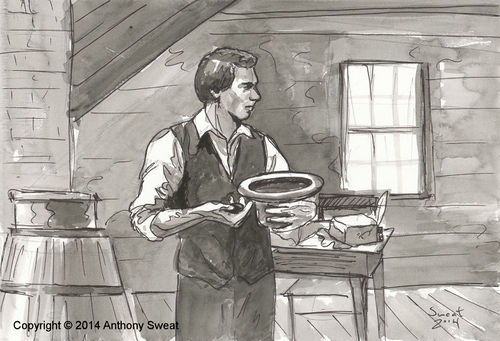
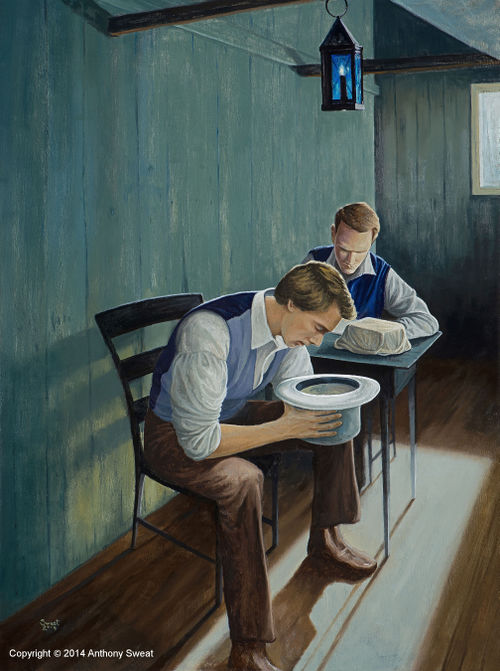
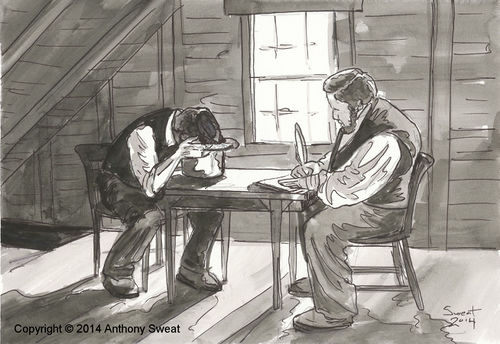
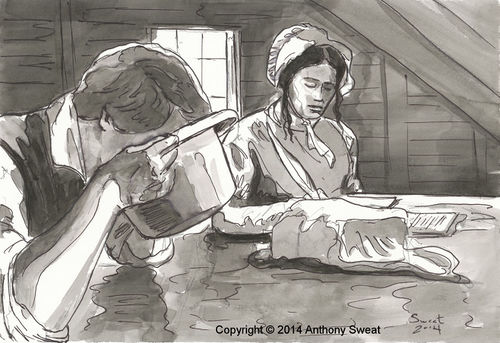
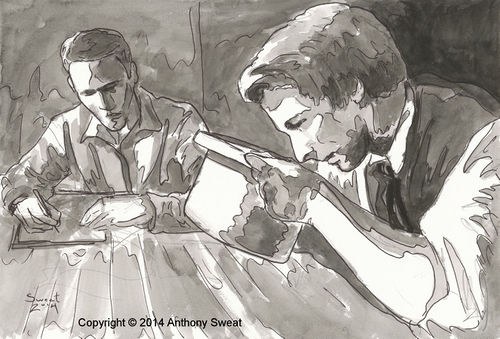
O Urim e Tumim era "um instrumento preparado por Deus para ajudar o homem a obter revelação do Senhor e na tradução de línguas" (Bible Dictionary, "Urim e Tumim"). Joseph Smith usou o Urim e Tumim para auxiliar na tradução do Livro de Mórmon. Além do Urim e Tumim, o Profeta usou uma pedra de vidente no processo de tradução.
Élder Neal A. Maxwell, do Quórum dos Doze Apóstolos, disse o seguinte sobre o processo de tradução e de utilização de Joseph Smith do Urim e Tumim eo pedra de vidente:
"O Profeta Joseph sozinho sabia o processo completo, e ele foi deliberadamente relutantes em descrever detalhes. Tomamos passando conhecimento das palavras de David Whitmer, Joseph Knight, e Martin Harris, que eram observadores, não tradutores. David Whitmer indicou que como o Profeta usou os instrumentos divinos fornecidas para ajudá-lo, 'os hieróglifos que parece, e também a tradução no idioma Inglês ... em letras luminosas brilhantes. "Então Joseph leria as palavras de Oliver (citado em James H. Hart, “About the Book of Mormon,” Deseret Evening News, 25 Mar. 1884, 2). 'Martin Harris relacionados da pedra vidente ':' sentenças apareciam e eram lidas pelo profeta e escritas por Martin ' (citado em Edward Stevenson, “One of the Three Witnesses: Incidents in the Life of Martin Harris,” Latter-day Saints’ Millennial Star, 6 Feb. 1882, 86–87). Joseph Knight fez observações semelhantes (ver Dean Jessee, “Joseph Knight’s Recollection of Early Mormon History,” BYU Studies 17 [Autumn 1976]: 35).
"Lesson 10: Joseph Smith—History 1:55–65," Manual de Doutrina e Convênios e História da Igreja do Seminário de Professores, 2013 (available online at LDS.org)
Two accounts of the translation process, including the use of a seer stone, have been written by members of the Quorum of the Twelve Apostles and published in Church magazines. Historians have also written about the seer stone in Church publications, both in the Ensign and in The Joseph Smith Papers. (See Neal A. Maxwell, “‘By the Gift and Power of God,’” Ensign, Jan. 1997, 36–41; Russell M. Nelson, “A Treasured Testament,” Ensign, July 1993, 61–63; Richard Lloyd Anderson, “‘By the Gift and Power of God,’” Ensign, Sept. 1977, 78–85; and Documents, Volume 1: July 1828–June 1831, xxix–xxxii.)
—"Book of Mormon Translation," Gospel Topics on lds.org off-site
Gerrit Dirkmaat (Church History Department - January 2013 Ensign):
Those who believed that Joseph Smith’s revelations contained the voice of the Lord speaking to them also accepted the miraculous ways in which the revelations were received. Some of the Prophet Joseph’s earliest revelations came through the same means by which he translated the Book of Mormon from the gold plates. In the stone box containing the gold plates, Joseph found what Book of Mormon prophets referred to as “interpreters,” or a “stone, which shall shine forth in darkness unto light” (Alma 37:23–24). He described the instrument as “spectacles” and referred to it using an Old Testament term, Urim and Thummim (see Exodus 28:30).2
He also sometimes applied the term to other stones he possessed, called “seer stones” because they aided him in receiving revelations as a seer. The Prophet received some early revelations through the use of these seer stones. For example, shortly after Oliver Cowdery came to serve as a scribe for Joseph Smith as he translated the plates, Oliver and Joseph debated the meaning of a biblical passage and sought an answer through revelation. Joseph explained: “A difference of opinion arising between us about the account of John the Apostle … whether he died, or whether he continued; we mutually agreed to settle it by the Urim and Thummim.”3 In response, Joseph Smith received the revelation now known as section 7 of the Doctrine and Covenants, which informed them that Jesus had told the Apostle John, “Thou shalt tarry until I come in my glory” (D&C 7:3).
Records indicate that soon after the founding of the Church in 1830, the Prophet stopped using the seer stones as a regular means of receiving revelations. Instead, he dictated the revelations after inquiring of the Lord without employing an external instrument. One of his scribes explained that process: “The scribe seats himself at a desk or table, with pen, ink, and paper. The subject of inquiry being understood, the Prophet and Revelator inquires of God. He spiritually sees, hears, and feels, and then speaks as he is moved upon by the Holy Ghost.”
Gerrit Dirkmaat (Church History Department), "Great and Marvelous Are the Revelations of God," Ensign, January 2013. (emphasis added) off-site
In 2005, Opening the Heavens was published jointly by the Joseph Fielding Smith Institute for Latter-day Saint History and Deseret Book. As part of this book, at least twenty-nine references to the stone (often with the hat) are included, from both friendly and hostile sources:
"Martin Harris related of the seer stone: 'Sentences would appear and were read by the Prophet and written by Martin'"
—Neal A. Maxwell, “‘By the Gift and Power of God’,” Ensign, January 1997, 36 (emphasis added) off-site
"David Whitmer wrote: ' Joseph Smith would put the seer stone into a hat, and put his face in the hat, drawing it closely around his face to exclude the light; and in the darkness the spiritual light would shine.'"
—Russell M. Nelson, “A Treasured Testament,” Ensign, Jul 1993, 61. (emphasis added) off-site
"Jacob censured the "stiffnecked" Jews for "looking beyond the mark" (Jacob 4:14). We are looking beyond the mark today, for example, if we are more interested in the physical dimensions of the cross than in what Jesus achieved thereon; or when we neglect Alma's words on faith because we are too fascinated by the light-shielding hat reportedly used by Joseph Smith during some of the translating of the Book of Mormon. To neglect substance while focusing on process is another form of unsubmissively looking beyond the mark."
—Neal A. Maxwell, Not My Will, But Thine (Salt Lake City, Utah: Bookcraft, 1988), 26.
The scriptures indicate that translation involved sight, power, transcription of the characters, the Urim and Thummim or a seerstone, study, and prayer.
After returning from a trip to Palmyra to settle his affairs, Martin began to transcribe. From April 12 to June 14, Joseph translated while Martin wrote, with only a curtain between them. On occasion they took breaks from the arduous task, sometimes going to the river and throwing stones. Once Martin found a rock closely resembling the seerstone Joseph sometimes used in place of the interpreters and substituted it without the Prophet’s knowledge. When the translation resumed, Joseph paused for a long time and then exclaimed, “Martin, what is the matter, all is as dark as Egypt.” Martin then confessed that he wished to “stop the mouths of fools” who told him that the Prophet memorized sentences and merely repeated them." —Kenneth W. Godfrey, "A New Prophet and a New Scripture: The Coming Forth of the Book of Mormon," Ensign (Jan 1988).
"There he gave his most detailed view of 'the manner in which the Book of Mormon was translated': “Joseph Smith would put the seer stone into a hat and put his face in the hat, drawing it closely around his face to exclude the light."
—Richard Lloyd Anderson, "‘By the Gift and Power of God’," Ensign (Sep 1977), 79, emphasis added. off-site
"To help him with the translation, Joseph found with the gold plates “a curious instrument which the ancients called Urim and Thummim, which consisted of two transparent stones set in a rim of a bow fastened to a breastplate.” Joseph also used an egg-shaped, brown rock for translating called a seer stone."
—“A Peaceful Heart,” Friend, Sep 1974, 7 off-site

FAIR is a non-profit organization dedicated to providing well-documented answers to criticisms of the doctrine, practice, and history of The Church of Jesus Christ of Latter-day Saints.
We are a volunteer organization. We invite you to give back.
Donate Now